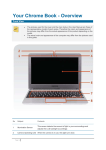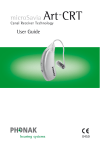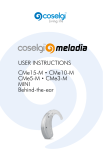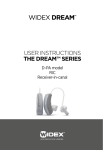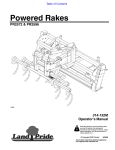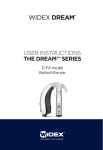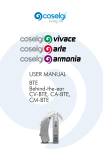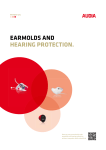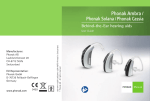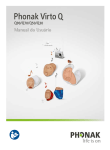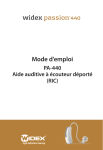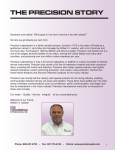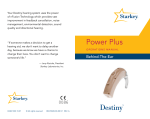Download user manual ear-sets for widex bte hearing aids
Transcript
USER MANUAL EAR-SETS FOR WIDEX BTE HEARING AIDS CONTENTS INTRODUCTION. . . . . . . . . . . . . . . . . . . . . . . . . . . . . . . . . . . . . . . . 3 OVERVIEW AND CHECK BOXES . . . . . . . . . . . . . . . . . . . . . . . . . . 4 INSTANT EAR-TIPS . . . . . . . . . . . . . . . . . . . . . . . . . . . . . . . . . . . . . 8 Left/right identification . . . . . . . . . . . . . . . . . . . . . . . . . . . . . . . . . 9 Positioning the hearing aid and instant ear-tip . . . . . . . . . . . . 10 Removing the hearing aid and instant ear-tip . . . . . . . . . . . . . 11 Cleaning . . . . . . . . . . . . . . . . . . . . . . . . . . . . . . . . . . . . . . . . . . . . . . 12 Changing the ear-set parts . . . . . . . . . . . . . . . . . . . . . . . . . . . . . 19 CUSTOM EAR-TIPS . . . . . . . . . . . . . . . . . . . . . . . . . . . . . . . . . . . . 22 Left/right identification . . . . . . . . . . . . . . . . . . . . . . . . . . . . . . . . 23 Positioning the hearing aid and custom ear-tip. . . . . . . . . . . . 24 Removing the hearing aid and custom ear-tip. . . . . . . . . . . . . 25 Cleaning . . . . . . . . . . . . . . . . . . . . . . . . . . . . . . . . . . . . . . . . . . . . . . 26 Changing the ear-set parts . . . . . . . . . . . . . . . . . . . . . . . . . . . . . 33 CUSTOM EARMOLDS . . . . . . . . . . . . . . . . . . . . . . . . . . . . . . . . . . 35 Left/right identification . . . . . . . . . . . . . . . . . . . . . . . . . . . . . . . . 36 Positioning the hearing aid and earmold . . . . . . . . . . . . . . . . . 37 Removing the hearing aid and earmold . . . . . . . . . . . . . . . . . . 38 Cleaning . . . . . . . . . . . . . . . . . . . . . . . . . . . . . . . . . . . . . . . . . . . . . . 39 Changing the ear-set parts . . . . . . . . . . . . . . . . . . . . . . . . . . . . . 43 THE WAX GUARD . . . . . . . . . . . . . . . . . . . . . . . . . . . . . . . . . . . . . 44 Changing the wax guard . . . . . . . . . . . . . . . . . . . . . . . . . . . . . . . 45 THE ANCHOR . . . . . . . . . . . . . . . . . . . . . . . . . . . . . . . . . . . . . . . . . 49 TROUBLESHOOTING . . . . . . . . . . . . . . . . . . . . . . . . . . . . . . . . . . 58 Ear-tips and earmolds with an earwire . . . . . . . . . . . . . . . . . . . 58 Ear-tips and earmolds with a tube . . . . . . . . . . . . . . . . . . . . . . . 60 MAINTENANCE . . . . . . . . . . . . . . . . . . . . . . . . . . . . . . . . . . . . . . . 62 2 INTRODUCTION This booklet provides an overview of different ear-set solutions available for Widex behind-the-ear (BTE) hearing aids. An ear-set consists of an ear-tip or earmold attached to a tube or an earwire. The ear-set is used to channel sound from the behind-the-ear hearing aid into the ear canal. WARNING This booklet contains important information and instructions regarding your ear-set, and complements the user instructions for your hearing aid. In addition to the user instructions for your hearing aid, please be sure to read the sections in this booklet that apply to your ear-set solution before you start using the hearing aid. NOTE Your ear-set may not look exactly as illustrated in this booklet. We also reserve the right to make any changes considered necessary. 3 OVERVIEW AND CHECK BOXES Your hearing care professional should check the box of the chosen solution. Instant ear-tips Instant receiver ear-tip & RIC earwire ❑ ❑ ❑ ❑ ❑ ❑ ❑ Instant receiver open ear-tip, for RIC M Instant receiver tulip ear-tip, for RIC P & M Instant receiver double ear-tip, for RIC P & M Instant receiver open ear-tip, for RIC 1 Instant receiver tulip ear-tip, for RIC 1 Instant receiver double ear-tip, for RIC 1 Instant receiver flex ear-tip, for RIC 1 Sections to read Introduction Overview and check boxes Instant ear-tips The wax guard The anchor Troubleshooting Maintenance from page 3 4 8 44 49 58 62 Hearing aid model: ______________________ Earwire/tube size: Left _____ Right ______ Ear-tip size: Left _____ Right ______ 4 Instant ear-tip & élan tube ❑ Instant open ear-tip, for élan tube ❑ Instant tulip ear-tip, for élan tube ❑ Instant double ear-tip, for élan tube Sections to read Introduction Overview and check boxes Instant ear-tips The anchor Troubleshooting Maintenance from page 3 4 8 49 60 62 Hearing aid model: ______________________ Earwire/tube size: Left _____ Right ______ Ear-tip size: Left _____ Right ______ cont. 5 Custom ear-tips Custom receiver ear-tip & RIC earwire ❑ Custom receiver open hard ear-tip, for RIC M ❑ Custom receiver hard ear-tip, for RIC P, M & 1 ❑ Custom receiver soft ear-tip, for RIC P, M & 1 Sections to read Introduction Overview and check boxes Custom ear-tips The wax guard Troubleshooting Maintenance from page 3 4 22 44 58 62 Custom ear-tip & élan tube ❑ Custom open hard ear-tip, for élan tube ❑ Custom flex hard ear-tip, for élan tube ❑ Custom flex soft ear-tip, for élan tube Sections to read Introduction Overview and check boxes Custom ear-tips The anchor Troubleshooting Maintenance from page 3 4 22 53 60 62 Hearing aid model: ______________________ Earwire/tube size: Left _____ Right ______ 6 Custom earmolds Custom receiver earmold & RITE earwire ❑ Custom hard earmold, Regular sound bore, for RITE ❑ Custom hard earmold, Output Extender, for RITE Sections to read Introduction Overview and check boxes Custom earmolds The wax guard Troubleshooting Maintenance from page 3 4 35 44 58 62 Custom earmold & classic tube ❑ Custom open hard classic mold, for classic tube ❑ Custom flex hard classic mold, for classic tube ❑ Custom flex soft classic mold, for classic tube Sections to read Introduction Overview and check boxes Custom earmolds Troubleshooting Maintenance from page 3 4 35 60 62 Hearing aid model: ______________________ Earwire/tube size: Left _____ Right ______ 7 INSTANT EAR-TIPS The instant ear-tip is used with a RIC earwire or an élan tube, depending on the hearing aid model. In a RIC solution, the receiver or loudspeaker of the hearing aid is placed at the end of the earwire. In an élan solution, the receiver is located inside the hearing aid housing. Under “Overview and Check Boxes”, you can see which solution has been chosen for you. élan m-models RIC 1. Earwire 2. Receiver élan 9-models 1 2 Open ear-tip Double ear-tip Tulip ear-tip Flex ear-tip 8 Left/right identification The illustration shows an earwire. Earwires/tubes are available in different lengths for the right and left ear, respectively. The individual size is printed on the earwire/tube (see arrow). Red print indicates that it is for the right ear, and blue print that it is for the left ear. 9 Positioning the hearing aid and instant ear-tip The illustrations show an open ear-tip, but the same procedure is used for the other instant ear-tip types. Place the hearing aid behind the ear, so that the earwire/tube rests comfortably on the ear, close to your head. Insert the ear-tip into the ear canal while holding the lower part of the earwire/tube. If you have a tulip ear-tip, make sure that the larger leaf is positioned over and overlaps the smaller leaf. An anchor is used for some instant ear-tips to help secure the ear-set in the ear. Please refer to page 49 for further information. 10 Removing the hearing aid and instant ear-tip Remove the hearing aid from its position behind the ear. Carefully pull the ear-tip out of the ear canal, while holding the lower part of the earwire/tube. 11 Cleaning Cleaning accessories*. 1. Cloth 2. Long wax removing tool 3. Short wax removing tool 4. Brush 5. Cleaning thread 4 1 2 3 5 Contact your hearing care professional if you need additional supplies of cleaning accessories. * Selection depends on ear-set type. 12 The ear-set Make sure that your ear-set is always clean and free of earwax, moisture and the like. WARNING Never use alcohol or other cleaning solutions to clean the earset, as this can discolour it. 13 The RIC earwire Clean the earwire with the cloth after use. WARNING Never use water or cleaning solutions to clean the earwire. The receiver must never come into contact with water, as this can damage the receiver. If dirt has collected on the receiver, use the cloth to remove it, after first pulling the receiver out of the eartip. 14 The élan tube - for m-models Cleaning a blocked tubing: Grip the hearing aid between your thumb and index finger. With your other hand grip the tubing and pull straight apart as indicated by the arrow. Alternatively, a small tool is available for removing the tubing. Contact your hearing care professional if you want more information. Pull the ear-tip off the tubing. The illustrations show an open ear-tip. Pass the cleaning thread through the tubing. Pull the thread out at the other end. 15 The élan tube - for 9-models Cleaning a blocked tubing: Lift the ear-set off the hearing aid in a slanting, backward movement, as shown. Pull the ear-tip off the tubing. The illustrations show an instant open ear-tip. Pass the cleaning thread through the tubing. Pull the thread out at the other end. 16 The instant ear-tips Flex ear-tip: First remove the NanoCare wax guard (see page 45), then use the wax guard holder to push the receiver out of the ear-tip. Clean the vent with the long wax removing tool (no. 2), as illustrated. Clean the sound bore with the short wax removing tool (no. 3), as illustrated. 17 Open, tulip, double & flex ear-tip: If necessary, the ear-tip can be rinsed thoroughly in lukewarm water, after disconnecting it from the rest of the ear-set. Allow it to dry overnight. WARNING Never use cleaning solutions to clean the ear-tip, as this can discolour it. Ear-tips in which a receiver is inserted use a wax guard. Please refer to page 44. 18 Changing the ear-set parts The ear-set parts should be changed as required. The life of an ear-set is individual. Consult your hearing care professional for advice on how often you should change your ear-set parts. For further supplies of ear-sets, or if the ear-tip size no longer fits your ear, contact your hearing care professional. 19 Placing the new/clean ear-tip on the ear-set Gently insert the earwire/tubing into the ear-tip. It is very important to ensure that the ear-tip is firmly secured. Flex ear-tip: The right/left identification mark should still be visible. See arrow. Open, tulip, double ear-tip: 20 NOTE Some ear-tips have a short inner collar. When inserting the receiver into an ear-tip with a short collar, you should feel it click into place. The instant receiver double ear-tip may be provided with a vent. If a closed solution has been chosen, the vent will be blocked by a vent block. When you replace the ear-tip, you will therefore also need to insert a new vent block. Insert the pointed end of the block all the way into the vent from the inside, as shown. Break off the pointed end. Make sure it sits securely in the vent. 21 CUSTOM EAR-TIPS The custom ear-tip is used with a RIC earwire or an élan tube, depending on the hearing aid model. In a RIC solution, the receiver or loudspeaker of the hearing aid is placed at the end of the earwire, inside the ear-tip. In an élan solution, the receiver is located inside the hearing aid housing. Under “Overview and Check Boxes”, you can see which solution has been chosen for you. élan m-models RIC 1. Earwire 2. Receiver (inside the ear-tip) élan 9-models 1 2 Hard ear-tip Flex hard ear-tip Soft ear-tip Flex soft ear-tip Open hard ear-tip (RIC) Open hard ear-tip 22 Left/right identification Earwires/tubes are available in different lengths for the right and left ear, respectively. The individual size is printed on the earwire/tube. Red print indicates that it is for the right ear, and blue print that it is for the left ear. The hard ear-tip has ”Widex” printed on it (see arrow). Red print indicates that it is for the right ear, and blue print that it is for the left ear. Similarly, the soft ear-tip will have either a red or a blue dot. 23 Positioning the hearing aid and custom ear-tip Insert the ear-tip into the ear canal while holding the lower part of the earwire/tube. It may also help to pull the outer ear backwards and upwards with the opposite hand. Place the hearing aid behind the ear, so that the hearing aid and earwire/tube rest comfortably on the ear, close to your head. A trimmed integrated anchor is used in the élan solution for 9-model hearing aids to help keep the ear-tip correctly positioned. Please refer to page 57 for further information. 24 Removing the hearing aid and custom ear-tip Remove the hearing aid from its position behind the ear. Take hold of the extraction cord and carefully pull the custom ear-tip out of the ear canal. CAUTION Do not pull the earwire/tubing to remove your hearing aid. Use the extraction cord. 25 Cleaning Cleaning accessories*. 1. Cloth 2. Brush 3. Wax removing tool 4. Cleaning thread 3 1 4 2 Contact your hearing care professional if you need additional supplies of cleaning accessories. * Selection depends on ear-set type 26 The ear-set Make sure that your ear-set is always clean and free of earwax, moisture and the like. WARNING Never use alcohol or other cleaning solutions to clean the earset, as this can discolour it. 27 The RIC earwire Clean the earwire with the cloth after use. WARNING Never use water or cleaning solutions to clean the earwire, as it can damage it. The receiver must never come into contact with water, as this can damage the receiver. CAUTION Never attempt to disconnect the earwire from the custom eartip as this can break the connection between the earwire and the ear-tip. 28 The élan tube - for m-models Cleaning a blocked tubing: Grip the hearing aid between your thumb and index finger. With your other hand grip the tubing and pull straight apart as indicated by the arrow. Alternatively, a small tool is available for removing the tubing. Contact your hearing care professional if you want more information. Carefully pull the custom eartip off the tubing, wriggling the tip of the tubing gently. Pass the cleaning thread through the tubing. Pull the thread out at the other end. 29 The élan tube - for 9-models Cleaning a blocked tubing: Lift the ear-set off the hearing aid in a slanting, backward movement, as shown. Carefully pull the custom eartip off the tubing, wriggling the tip of the tubing gently. Pass the cleaning thread through the tubing. Pull the thread out at the other end. 30 The custom ear-tips With RIC earwire If dirt has collected on the custom ear-tip, remove and discard the wax guard (see page 45). Do not attempt to clean the wax guard. Use the small brush or cloth to remove any remaining debris from the opening of the ear-tip. If your custom hard ear-tip is provided with a vent, use the wax removing tool to clean the vent. The custom soft ear-tip may be provided with an exterior vent. Use the small brush to clean the vent. CAUTION Never attempt to disconnect the earwire from the custom eartip as this can break the connection between the earwire and the ear-tip. 31 With élan tube If necessary, the ear-tips used with élan tubing can be rinsed thoroughly in lukewarm water after disconnecting it from the rest of the earset. Allow it to dry overnight. Ear-tips in which a receiver is inserted use a wax guard. Please refer to page 44. 32 Changing the ear-set parts RIC earwire: Changing an earwire requires special tools and experience. We recommend that you consult your hearing care professional when the earwire needs replacement. WARNING Do not attempt to change the earwire yourself as this can break the connection to the receiver or the hearing aid. If the ear-tip no longer fits your ear, contact your hearing care professional. élan tube: The tubing should be changed as required. Consult your hearing care professional for advice on how often you should change the tubing. For further supplies of tubing or if the custom ear-tip no longer fits your ear, contact your hearing care professional. 33 Placing the new/clean ear-tip on the élan ear-set On page 57 you can see how to trim the anchor. Hold the custom ear-tip between two fingers, with the extraction cord downwards. Hold the tubing with the other hand as illustrated. Gently press the tubing into place in the custom ear-tip. Use your fingernail to press the tubing in as far as it will go so that it is securely fastened. Click the ear-set onto the top of the hearing aid as illustrated. 34 CUSTOM EARMOLDS The custom earmold is used with a RITE earwire or a classic tube, depending on the hearing aid model. In a RITE solution, the receiver or loudspeaker of the hearing aid is placed at the end of the earwire, inside the earmold. The classic tube is attached to an earhook on the hearing aid, while the receiver is located inside the hearing aid housing. Under “Overview and Check Boxes”, you can see which solution has been chosen for you. 1. Classic tube 2. Earhook 1. Custom receiver hard earmold 2. Earwire 2 2 1 1 Classic mold Custom receiver hard earmold 35 Left/right identification The custom receiver hard earmold has ”Widex” printed on it. Red print indicates that the earmold is for the right ear, and blue print indicates that it is for the left ear. 36 Positioning the hearing aid and earmold Insert the classic mold in the ear canal while holding the lower part of the tubing. If you have a custom receiver hard earmold, hold the earmold with your thumb and forefinger and slowly guide it into your ear canal until you feel resistance. Let go of the earmold and use the tip of your forefinger to gently push it into your ear until it rests comfortably in your ear canal. To help position the earmold properly you could pull the outer ear backwards and upwards with the opposite hand. Place the hearing aid behind the ear, so that the tubing/earwire rests comfortably on the ear, close to your head. 37 Removing the hearing aid and earmold Remove the hearing aid from its position behind the ear. Carefully pull the classic earmold out of the ear canal, while holding the lower part of the tubing. If you have a custom receiver hard earmold, hold it with your thumb and forefinger and pull gently. WARNING Do not pull the earwire to remove the custom receiver hard earmold, as this can damage the receiver. If it is difficult, you can try to move the earmold carefully from side to side. It may also help to pull the outer ear backwards and upwards with the opposite hand. 38 Cleaning Cleaning accessories*. 1. Soft cloth 2. Brush 3. Wax removing tool 3 1 2 Contact your hearing care professional if you need additional supplies of cleaning accessories. * Selection depends on ear-set type 39 The ear-set Make sure that your ear-set is always clean and free of earwax and moisture. WARNING Never use alcohol or other cleaning solutions to clean the earset as this can discolour it. The custom hard earmold in which the receiver is placed must never come into contact with water, as this can damage the receiver. Classic earmold: Disconnect the earmold from the tubing. Clean the vent with the wax removing tool. Clean the sound bore with the wax removing tool. 40 At least once a week disconnect the earmold from the tubing and rinse the earmold thoroughly in lukewarm water. Allow it to dry overnight. If there is still moisture in the earmold, use a blower or similar to blow it dry before attaching the earmold to the tubing. Custom receiver hard earmold Clean your earmold with the soft cloth after use to keep it dry and clean of earwax or dirt. 41 The sound outlet It is important that the sound outlet is not blocked by earwax. If it is blocked, change the wax guard (see page 45). Do not attempt to clean the wax guard. The vent If your earmold is provided with an exterior vent, use the brush to clean it. WARNING The earmold in which the receiver is placed must never come into contact with water, as it can damage the receiver. The earwire Clean the earwire with the cloth after use. WARNING Never use water or cleaning solutions to clean the earwire, as it can damage it CAUTION Never attempt to disconnect the earwire from the custom earmold as this can break the connection between the earwire and the earmold. 42 Changing the ear-set parts Classic earmold If your ear-set tubing becomes slack, stiff, yellow or cracked, replace the tubing. For further supplies of tubing or if the earmold no longer fits your ear, contact your hearing care professional. Custom hard earmold Changing an earwire requires special tools and experience. We recommend that you consult your hearing care professional when the earwire needs replacement. WARNING Do not attempt to change the earwire yourself as this can break the connection to the receiver or the hearing aid. If the custom hard earmold no longer fits your ear, contact your hearing care professional. 43 THE WAX GUARD A wax guard is used with RIC and RITE solutions, in which the receiver sits in the ear-tip/earmold. The wax guard helps to protect the hearing aid against earwax. Always use NanoCare wax guards with your hearing aid if you have a RIC solution, and CeruSTOP XL wax guards if you have a RITE solution, otherwise the warranty for your hearing aid will be void. The illustration shows a NanoCare wax guard. The wax guard system consists of the following parts: 1. Holder 2. Removal hook 3. Wax guard 1 3 2 CAUTION The wax guard is disposable and for one-time use only. Do not attempt to clean or reuse a wax guard. This could damage your hearing aid and/or cause the wax guard to become dislodged in your ear. 44 Changing the wax guard Custom receiver ear-tips/earmolds CAUTION Do NOT remove the ear-tip/earmold from the earwire. Instant receiver ear-tips Remove the ear-tip from the earwire. NOTE With some instant ear-tip types, the wax guard can also be changed without first removing the ear-tip from the earwire. If in doubt, consult your hearing care professional. 45 Procedure: 1. Insert the removal hook into the used wax guard placed in the sound outlet. 2. Pull the wax guard straight out. Custom receiver ear-tips/earmolds 1 2 Instant receiver ear-tips 1 2 Now turn the holder around so that the used wax guard is away from the receiver and the new one is in position to be inserted. 46 3. Insert the holder into the opening of the sound outlet and gently press the wax guard onto the receiver. 4. Pull the holder straight out. The new wax guard will automatically detach from the holder. Press the receiver/ear-tip gently against a flat surface to ensure that the wax guard remains in place. Custom receiver ear-tips/earmolds 3. 4. Instant receiver ear-tips 3. 4. 47 Discard the holder with the used wax guard. The frequency with which the wax guard should be changed varies from one individual to another. If you have any questions regarding your wax guard, please contact your hearing care professional. WARNING If the wax guard fits loosely, discard it and insert another. If the wax guard becomes dislodged while the ear-tip is placed in the ear canal, please contact your physician. Do not try to remove the wax guard from your ear canal yourself. 48 THE ANCHOR Loose anchor CAUTION We do not recommend wearing the hearing aid without the anchor with the open ear-tip or the tulip ear-tip solution. If the hearing aid is not secured by the anchor, it may fall off your ear and be lost. With the flex ear-tip, the anchor should only be used if this is necessary to further secure the ear-set/hearing aid. The anchor is not used with the double ear-tip or custom ear-tips. The anchor is supplied separately from the rest of the ear-set and can be used in different ways. Firstly, we show how the anchor can be used without prior trimming: 49 The illustrations show a hearing aid with an an instant open receiver eartip but the same procedure is used with a tulip ear-tip and a flex ear-tip. Pull the pointed end of the anchor through the upper hole on the receiver located at the end of the earwire. The angled grip should be pointing towards the hearing aid. Continue pulling until the anchor is stopped by the grip at the end. Your ear-set is now ready for use and is positioned so that it rests comfortably in your ear. 50 The anchor can also be trimmed to fit your ear: Pull the pointed end of the anchor through the upper hole on the receiver located at the end of the earwire. The angled grip should be pointing towards the hearing aid. Continue pulling until the anchor is stopped by the grip at the end. Now turn the ear-set around. Then guide the pointed end of the anchor through the lower hole to form a loop. When the loop is the correct size, cut any excess off, leaving only the loop. The anchor loop has the correct size when it supports the position of the ear-tip in the ear canal, and the earset sits securely in and on the ear. 51 Take great care to cut off all the excess so that the end of the anchor loop is flush with the small hole and there are no sharp edges. Use the tip of your finger to check for sharp edges. If part of the anchor sticks out through the hole, creating an uneven surface, this may cause irritation of the ear. 52 THE ANCHOR Integrated anchor Instant ear-tips The anchor is not used for an instant double ear-tip solution and should be completely cut off. For the open ear-tip and tulip ear-tip solution, the anchor can be used without prior trimming. If trimmed, it should form an appropriately sized loop to ensure the comfortable retention of the ear-tip in the ear canal. There are several ways of doing this: The illustrations show a hearing aid with an instant open ear-tip, but the same procedure is used with a tulip ear-tip. 53 Example 1 Pull the tip of the anchor through the small hole on the side of the tubing. When the loop is the correct size, cut off any excess with scissors or similar. 54 Example 2 Loop the anchor in the direction indicated by the dotted line and arrows. Guide the tip of the anchor through the small hole on the side of the tubing as illustrated to form a heartshaped loop. When the loop is the correct size, turn the ear-set around and cut off any excess with scissors or similar. 55 General information: Make sure that the end of the anchor loop is flush with the small hole and there are no sharp edges. Use the tip of your finger to check for sharp edges. If part of the anchor sticks out through the hole, creating an uneven surface, this may cause irritation of the ear. 56 Custom ear-tips With the custom ear-set solution only 2 mm of the anchor is used. Trim the anchor so there is approximately 2 mm left. It is important to leave the 2 mm intact as it helps keep the custom ear-tip correctly positioned. The tubing should look like this when you have trimmed the anchor. 57 TROUBLESHOOTING Ear-tips and earmolds with an earwire The following pages contain some advice on what to do if your hearing aid malfunctions or fails to perform satisfactorily. If the problems persist, contact your hearing care professional. The advice relates only to the ear-set. Please also see the user instructions for your hearing aid. The hearing aid is completely silent The wax guard is blocked Change the wax guard The earwire is broken Contact your hearing care professional The hearing aid volume is not powerful enough The wax guard is blocked Change the wax guard The hearing aid whistles continuously The earwire is yellow or stiff Contact your hearing care professional The ear-tip/earmold is not correctly placed in your ear canal Take the ear-tip/earmold out and reinsert it. If the problem persists, contact your hearing care professional 58 The ear-tip/earmold fit is too loose Contact your hearing care professional The receiver is not adequately secured in the ear-tip Instant ear-tip: Replace the ear-tip. If the problem persists, contact your hearing care professional Custom ear-tip: Contact your hearing care professional If the earmold is uncomfortable to wear Your outer ear or ear canal is sore It is important that first-time users only wear the hearing aid for short periods of time at the beginning. The skin in the ear canal is very thin and may swell a bit because of the pressure from the hearing aid. Take 2-3 weeks to gradually get used to the hearing aid. If the soreness continues, contact your hearing care professional. 59 TROUBLESHOOTING Ear-tips and earmolds with a tube The following pages contain some advice on what to do if your hearing aid malfunctions or fails to perform satisfactorily. If the problems persist, contact your hearing care professional. The advice relates only to the ear-set. Please also see the user instructions for your hearing aid. The hearing aid is completely silent or its volume is not powerful enough The sound outlet is blocked Earmold: Clean the blocked sound bore Instant ear-tip: Clean or replace the ear-tip Custom ear-tip: Clean the ear-tip The hearing aid whistles continuously The tubing is yellow, stiff or broken Replace the tubing The ear-tip/earmold is not correctly placed in your ear canal Take the ear-tip/earmold out and reinsert it. If the problem persists, contact your hearing care professional The ear-tip/earmold fit is too loose Contact your hearing care professional 60 Earmold: The tubing often comes off the earmold or hearing aid hook Replace the tubing Earmold: The hook is cracked Contact your hearing care professional 61 MAINTENANCE The hearing aid is a valuable object and should be treated with care. Here are some things you can do to prolong the life of your hearing aid: CAUTION • Turn off your hearing aid when it is not in use. Remove the battery if the hearing aid will not be used for several days. • When the hearing aid is not in use, keep it in its case in a cool, dry location out of reach of children and pets. • Do not expose the hearing aid to extreme temperatures or high humidity. Make sure to dry the hearing aid thoroughly after heavy perspiration such as that which may occur during intense physical activity, e.g. playing sports. • Avoid dropping your hearing aid – perform cleaning and battery changes while holding the hearing aid above a soft surface. • Do not wear your hearing aid while in the shower or swimming, or when using a hair dryer, perfume, hair and body sprays or gels such as suntanning lotions or creams. • In environments with high humidity, a drying kit may be used daily to reduce the amount of moisture inside the hearing aid. See the instructions enclosed with the drying kit . 62 Hearing aids, accessories and batteries should not be disposed of with normal household waste. Please consult your national Widex distributor for advice on how to dispose of these items. 63 Manufacturer CIB200/0411 ¡9 514 0176 041l¤ ¡#01v¤ Printed by HTO / 2011-04 9 514 0176 041 #01
































































